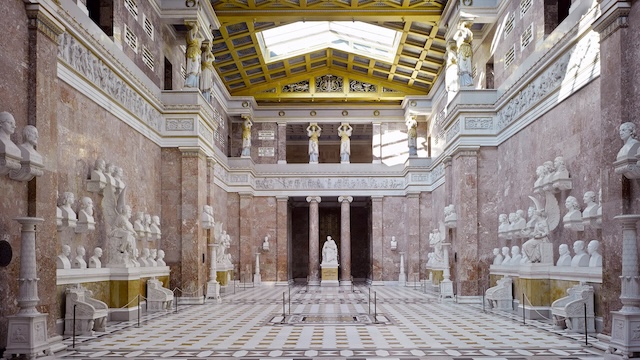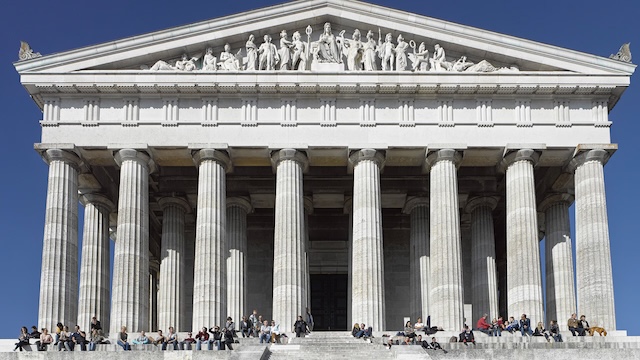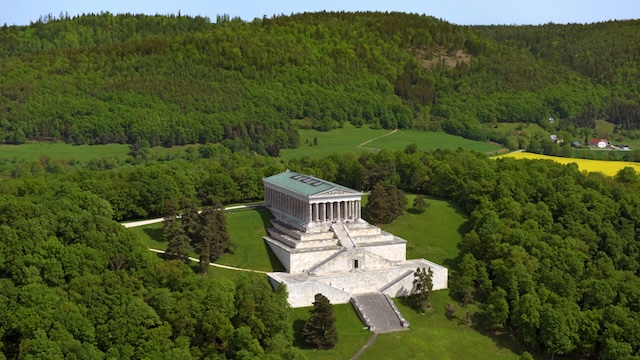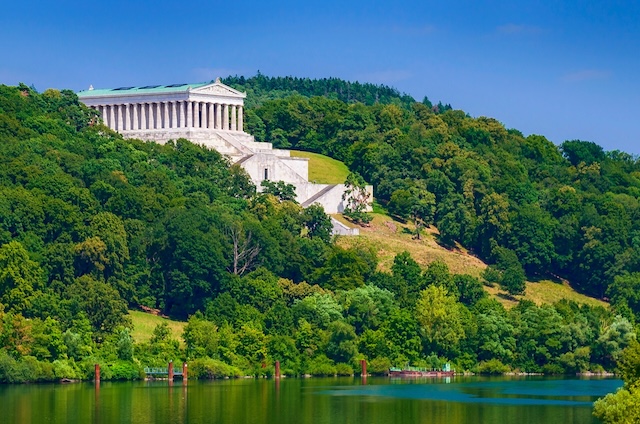Perched high on a hill overlooking the Danube River near Regensburg, Walhalla is one of Germany’s most extraordinary monuments. With its striking resemblance to a Greek temple and its deep historical significance, this masterpiece of Neoclassical architecture isn’t just a feast for the eyes – it’s also a profound celebration of German-speaking history and culture.
Let’s embark on a journey to explore the stories, inspiration, and vision behind this unique monument.
A Vision Born from Defeat
The story of Walhalla begins not in triumph, but in adversity. In 1807, after Germany faced a crushing defeat at the hands of Napoleon, a young Prince Ludwig (later King Ludwig I of Bavaria) was determined to reignite national pride. He dreamed of building a memorial that would honor the most remarkable German-speaking men and women throughout history – people who had contributed to art, science, politics, and beyond.

The name Walhalla was inspired by Valhalla, the mythical hall of fallen warriors in Norse mythology. However, Ludwig’s vision went far beyond honoring warriors. He wanted to celebrate all individuals whose achievements had shaped German culture and heritage. The monument would not only preserve their memory but also serve as a source of inspiration for future generations.
A Greek Temple with a German Heart
To bring his ambitious vision to life, Ludwig turned to Leo von Klenze, one of the most accomplished architects of the 19th century. Klenze began work on Walhalla in 1830, and after 12 years of meticulous effort, the monument was completed and inaugurated on October 18, 1842.
If the design looks familiar, that’s because Walhalla was heavily inspired by the Parthenon in Athens, one of the greatest architectural achievements of ancient Greece. However, Klenze added his own creative twist. The structure sits atop a massive, tiered foundation that gives it an imposing presence. The marble-clad temple is surrounded by columns and features a grand portico, but step inside, and you’ll find that it’s anything but a replica. The interior design is distinctly unique, reflecting the grandeur of its purpose.
Inside Walhalla: A Gallery of Greatness
Walking into Walhalla is like stepping into a hall of fame for German-speaking culture. The walls are lined with 96 marble busts of extraordinary individuals from history. Here, you’ll encounter the faces of Johannes Gutenberg (the inventor of the printing press), Nicolaus Copernicus (the astronomer who redefined our understanding of the universe), and Johann Wolfgang von Goethe (one of Germany’s greatest poets), among many others.
But what makes Walhalla even more intriguing is its inclusivity. It doesn’t only honor those whose names are etched in textbooks. For instance, there are plaques commemorating 64 individuals whose portraits weren’t available, ensuring their contributions are not forgotten.
The timeline of honorees spans centuries – from Arminius, a legendary warrior who defeated the Romans in 9 AD, to Peter Henlein, the inventor of the pocket watch. And Walhalla isn’t frozen in time. Since 1962, new busts have been added every few years to ensure the monument evolves with history. The selection process is rigorous, overseen by the Bavarian Council of Ministers with guidance from the Bavarian Academy of Sciences.

A Fusion of History and Mythology
Beyond its architecture and honorees, Walhalla holds a deeper symbolism. While its name pays homage to the Norse Valhalla, Ludwig I reimagined the concept to reflect a broader vision. This wasn’t just a place for warriors but a sanctuary for all who had left a lasting mark on society.
Above the busts, a stunning frieze by artist Martin von Wagner tells the story of the Germanic people, from their ancient migrations to their Christianization in the early Middle Ages. This artistic narrative blends history and mythology, creating a space that feels timeless and reverent.
A Monument with a View
The location of Walhalla is as spectacular as the building itself. Set atop a hill in Donaustauf, just a short drive from Regensburg, the monument offers panoramic views of the Danube River and the lush Bavarian countryside. On a clear day, the view alone is worth the visit. The combination of natural beauty and architectural brilliance makes it a favorite destination for history enthusiasts, architecture lovers, and travelers looking for a unique experience.

Walhalla’s Role Today
While Walhalla was initially conceived as a national monument, it has since become a cultural treasure that transcends its original purpose. Managed by the Bavarian Palace Administration since 2016, the monument continues to be a place of reflection and education. Each new addition to the gallery is a reminder that history is not static – it’s an ongoing story, and Walhalla is committed to telling it.
Visitors from around the world flock here to marvel at the marble halls, learn about the honorees, and soak in the incredible surroundings. Whether you’re a history buff, a fan of Neoclassical architecture, or just someone who appreciates a good view, Walhalla has something to offer.
Why Walhalla Matters
At its core, Walhalla is about more than marble busts or grand columns. It’s a celebration of human achievement and a testament to the power of remembering where we come from. For King Ludwig I, it was a way to unite a fragmented German-speaking world and inspire future generations. For visitors today, it’s a chance to connect with history, reflect on the accomplishments of the past, and dream about what the future might hold.

Your Journey Awaits
Standing before Walhalla, it’s impossible not to feel a sense of awe. The sheer scale of the monument, the artistry of its design, and the stories it holds all combine to create an experience that’s both humbling and inspiring.
So, whether you’re planning your next trip to Bavaria or just want to learn more about Germany’s cultural heritage, make sure Walhalla is on your list. It’s more than a building – it’s a timeless tribute to greatness. And who knows? Maybe one day, another remarkable name will be added to its marble halls, continuing the story of human achievement for generations to come.
